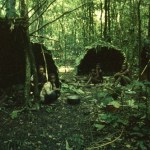efe
At the beginning of the 20th century, a traveler in Central Africa made mention of some strange people that he had come across. He was traveling among regular, run-of-the-mill natives…probably Bantu-speaking people living in scattered villages and farming for their food. But along the way, strange people came out of the forest. These strange people had sloping foreheads; they were short of stature, bow-legged and otherwise misshapen. They also clearly were, in the eyes of the traveler, of subhuman intelligence. The traveler described these people as a separate, subhuman race that lived in the…
I first became aware of, and read, King Leopold's Soliloquy, which is not his soliloquy but a parody of what he might say according to Samuel Clemens, while doing fieldwork in the ex-Belgian Congo. That is where the real story that inspired the essay took place. I lived in an area that at one time had a few a plantations, but the plantations only existed briefly and are now long gone. The "road" through this area was passable only with a very tenacious four wheel drive vehicle (we had a Land Rover) and grew worse every year. But the road at one time was excellent.
I knew a guy, an older…
Left: Efe (Pygmy) man. Right: White guy.
Some of the people who live in the rain forest of Central Africa are known widely as "Pgymies." That word...Pygmy...is considered problematic for a few different reasons. It refers to a person's physical appearance, because it means "small." The word is sometimes used in biology to refer to the smaller species among a group of closely related species, as in "Pygmy Hippopotamus" or "Pygmy Chimp." In English and probably some other languages, the term is used in a derogatory way to refer to someone who is perceived as not very smart, as in "Pygmy…
It has been said that our most distant primate ancestors, the mammal that gave rise to early primates but itself wasn't quite a primate, was most like the Asian tree shrew, which is neither a shrew nor does it live in trees. This is, of course, untrue. When the average American sees a shrew native to the new world scurrying past, he or she usually thinks of it as a form of mouse. Which it isn't. (In fact, there are no "mice" native to the new world, but even if we give our hypothetical observer the concept of "rodent" as in "eeek, a rodent" the shrew is not that either.) If you spend any…
An Efe forest camp is usually dark and depending on the time of day, dripping from current or recent rain. The Efe live in dome shaped huts which may be more or less complete. A half dome might be a hut that was built quickly, or it might be a hut that was built more openly because it has been hot or it might be only a half dome to allow easier access in and out of the hut by children or individuals with injury or infirmity. A fully domed hut, with a small opening, keeps in more smoke (a fire is often kept in the hut) but it also keeps in the heat and keeps out the rain. So a rainy…
It was a rare day that I was at the Ngodingodi research station at all ... usually I was off in the forest with the Efe Pygmies, up the road excavating an archaeological site. It was also rare that Grinker, my cultural anthropologist colleague, was at the research station. He was spending most of his time in the villages learning language and waiting around for the other shoe to drop (he studied conflict, so on the average day ... not much conflict).
But then an even rarer thing happened.
As we sat, being rare and chatting about the weather, we heard a the sound of a distant truck…


